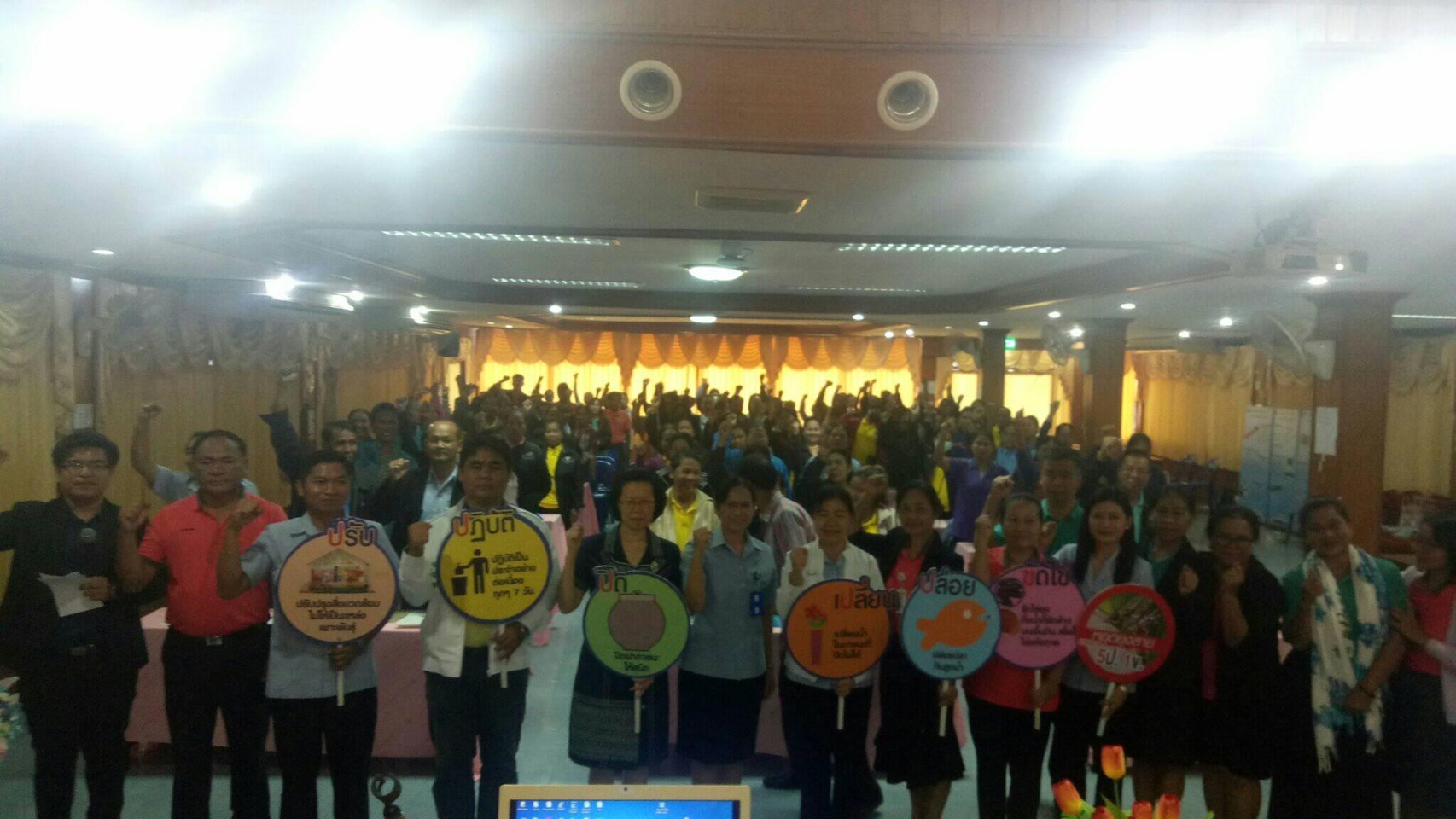ผลของการพัฒนาความรอบรู้ด้านสุขภาพเกี่ยวกับโรคมาลาเรียของอาสาสมัครสาธารณสุขประจำหมู่บ้านในเขตพื้นที่ชายแดนไทย-กัมพูชา จังหวัดศรีสะเกษ
คำสำคัญ:
ความรอบรู้ด้านสุขภาพ, ไข้มาลาเรีย, อาสาสมัครสาธารณสุขประจำหมู่บ้าน, พื้นที่ชายแดนไทย-กัมพูชาบทคัดย่อ
การวิจัยกึ่งทดลองครั้งนี้มีวัตถุประสงค์เพื่อศึกษาผลของการพัฒนาความรอบรู้ด้านสุขภาพเกี่ยวกับโรคไข้มาลาเรียของอาสาสมัครสาธารณสุขประจำหมู่บ้านในเขตพื้นที่ชายแดนไทย-กัมพูชา จังหวัดศรีสะเกษ จำนวน 238 คน ใน 3 อำเภอชายแดนไทย-กัมพูชา โดยใช้วิธีการสุ่มแบบกลุ่มจากโรงพยาบาลส่งเสริมสุขภาพตำบล เก็บรวมรวมข้อมูลด้วยแบบสอบถาม ก่อนและหลังการทดลอง ระหว่างวันที่ 1 กุมภาพันธ์ 2563 – 31 มีนาคม 2563 วิเคราะห์ข้อมูลเพื่อเปรียบเทียบผลต่างของคะแนนความรอบรู้ด้านสุขภาพเกี่ยวกับโรคไข้มาลาเรียโดยใช้สถิติ Multilevel mixed-effects linear regression นำเสนอด้วยค่า Mean difference และช่วงความเชื่อมั่น 95% พบว่า อสม.ส่วนใหญ่เป็นเพศหญิง ร้อยละ 71.43 อายุเฉลี่ย 47±9.79 ปี เคยป่วยเป็นไข้มาลาเรีย ร้อยละ 12.61 เคยได้รับการตรวจคัดกรองมาลาเรีย ร้อยละ 42.02 และเคยได้รับการอบรม ร้อยละ 70.71 ความรอบรู้ด้านสุขภาพเกี่ยวกับโรคไข้มาลาเรีย แยกรายด้าน พบว่า ด้านความรู้ ด้านการเข้าถึงข้อมูลและบริการสุขภาพ ด้านทักษะการสื่อสารและการสนับสนุนทางสังคม ด้านทักษะการตัดสินใจในการปฏิบัติตัว ด้านทักษะในการจัดการตนเอง และด้านทักษะการรู้เท่าทันสื่อ มีค่าเฉลี่ยคะแนนก่อนทดลอง เท่ากับ 7.95±1.61, 3.62±0.67, 3.56±0.89, 3.92±0.73, 3.77±0.94 และ 3.82±0.96 ตามลำดับ และหลังทดลองมีค่าเฉลี่ยคะแนนเท่ากับ 8.67±1.24, 4.02±0.52, 3.99±072, 4.15±0.48, 4.15±0.60 และ 4.20±0.66 ตามลำดับ คะแนนความรอบรู้ด้านสุขภาพในภาพรวมทั้งก่อนและหลังทดลองอยู่ในระดับสูงร้อยละ 56.72 และ 84.03 ตามลำดับ ผลการเปรียบเทียบคะแนนความรอบรู้ด้านสุขภาพก่อนและหลังทดลองแตกต่างกันอย่างมีนัยสำคัญทางสถิติ โดยพบว่า หลังทดลอง อสม.มีคะแนนความรอบรู้ด้านสุขภาพมากกว่าก่อนทดลอง 15.42 คะแนน (Adjusted mean difference = 15.42, 95% CI = 12.10-18.74 p-value<0.001) ดังนั้น เจ้าหน้าที่สาธารณสุขและหน่วยงานที่เกี่ยวข้องในพื้นที่ จึงควรนำรูปแบบการพัฒนาความรอบรู้ด้านสุขภาพนี้ไปประยุกต์ใช้ในการส่งเสริมความรอบรู้ด้านสุขภาพเกี่ยวกับการป้องกันโรคไข้มาลาเรียตามบริบทพื้นที่ให้มีประสิทธิภาพยิ่งขึ้นต่อไป
Downloads
เอกสารอ้างอิง
2. ประยุทธ สุดาทิพย์, เสาวนิต วิชัยขัทคะ, และสุธีรา พูลลิน. การประเมินผลการดำเนินงานควบคุมโรคมาลาเรีย โดยสำนักงานสาธารณสุขจังหวัด 43 จังหวัด ภายใต้โครงการกองทุนโลกรอบที่ 7: การประเมินเชิงนโยบายและผลกระทบการดำเนินงาน. วารสารสาธารณสุขล้านนา 2011: 225-239.
3. สำนักระบาดวิทยา. สรุปสถานการณ์โรคไข้มาลาเรีย ประจำปี 2561: รายงานในระบบเฝ้าระวังโรค. แหล่งข้อมูล: http://www.boe.moph.go.th/boedb/
surdata/506wk/y61/d30_5261.pdf. [สืบค้นเมื่อ 1 มิ.ย. 2563].
4. ปรีชา ปิยะพันธ์. พฤติกรรมการป้องกันโรคมาลาเรียของประชาชนพื้นที่ชายแดนไทย-กัมพูชา อำเภอภูสิงห์ จังหวัดศรีสะเกษ. วารสารสำนักงานป้องกันควบคุมโรคที่ 7. 2556; (4): 30-39.
5. กองโรคติดต่อนำโดยแมลง กรมควบคุมโรค. แนวทางการปฏิบัติงานกำจัดโรคไข้มาลาเรีย สำหรับบุคลากรทางการแพทย์และสาธารณสุขประเทศไทย. พิมพ์ครั้งที่ 1. กรุงเทพฯ: อักษรกราฟฟิคแอนด์ดีไซน์; 2562. 55-8.
6. คณะกรรมการอำนวยการจัดทำแผนพัฒนาสุขภาพแห่งชาติ ฉบับที่ 12 กระทรวงสาธารณสุข. แผนพัฒนาสุขภาพแห่งชาติ ฉบับที่ 12 พ.ศ. 2560-2564. [online]. แหล่งข้อมูล: http://wops.moph.go.th/ops/oic/data/
20180914162453_1_.pdf. [สืบค้นเมื่อ 1 มิ.ย. 2563].
7. เดือนนภา ศิริบูรณ์ และนพรัตน์ ส่งเสริม. ผลของโปรแกรมการเรียนรู้แบบมีส่วนร่วมต่อการป้องกันและควบคุมโรคมาลาเรียของตัวแทนครัวเรือนตำบลโดมประดิษฐ์ อำเภอน้ำยืน จังหวัดอุบลราชธานี. SNRU journal of science and Technology. 2016; 8(3): 292-300.
8. สมหมาย งึมประโดน, จิระภา ศิริวัฒนเมธานนท์ และสมศักดิ์ ศรีภักดี. การพัฒนารูปแบบการดำเนินงานป้องกันโรคมาลาเรียโดยการมีส่วนร่วมของชุมชน ตำบลหนองแวง อำเภอละหานทราย จังหวัดบุรีรัมย์. วารสารสำนักงานป้องกันควบคุมโรคที่ 7 จังหวัดขอนแก่น. 2559; 23(1): 35-45.
9. สุวรรณี สิริเศรษฐภักดี. การมีส่วนร่วมของชุมชนในการป้องกันโรคไข้มาลาเรียของประชาชนเขตพื้นที่ชายแดนไทย-กัมพูชา จังหวัดสุรินทร์. วารสารวิชาการสำนักงานป้องกันควบคุมโรคที่ 5 จังหวัดนครราชสีมา. 2555; 18(2): 44-55.
10. รุ่งนภา อาระหัง. ผลของโปรแกรมการส่งเสริมความรอบรู้ด้านสุขภาพต่อพฤติกรรมการป้องกันโรคความดันโลหิตสูงสำหรับกลุ่มเสี่ยงโรคความดันโลหิตสูงที่ชุมชนแห่งหนึ่งในจังหวัดนครปฐม (วิทยานิพนธ์ปริญญาพยาบาลศาสตรมหาบัณฑิต). ภาควิชาการพยาบาลเวชปฏิบัติชุมชน, คณะพยาบาลศาสตร์. กรุงเทพฯ; มหาวิทยาลัยคริสเตียน: 2560.
11. อุทัย เจริญจิตต์. ผลของการใช้โปรแกรมส่งเสริมสุขภาพในผู้ป่วยโรคเบาหวานต่อความรอบรู้ด้านสุขภาพแลพฤติกรรมตาม 3อ 2ส ของผู้ป่วยโรคเบาหวาน ศูนย์สุขภาพชุมชนเมือง โรงพยาบาลบ้านโป่ง. วารสารหัวหินสุขใจไกลกังวล. 2561; 3(2): 58-72.
12. จุพามณี กันกรุง. การศึกษาความฉลาดทางสุขภาวะของนักศึกษาปริญญาตรี มหาวิทยาลัยราชภัฎพิบูลสงคราม (วิทยานิพนธ์วิทยาศาสตรมหาบัณฑิต). พิษณุโลก; มหาวิทยาลัยราชภัฎพิบูลสงคราม: 2558.
13. Cho, Y. I., Lee, S. Y., Arozullah, A. M., & Crittenden, K. S. (2008). Effects of health literacy on health status and health service utilization among the elderly. Social Science & Medicine,
66(8), 1809-1816.
14. Von Wagner, C., Knight, k., Steptoe, A., & Wardle, J. (2007). Functional health literacy and health promoting behavior in a national sample of British adults. Journal Epidemio Community Health, 61(12), 1086-1090.

ดาวน์โหลด
เผยแพร่แล้ว
รูปแบบการอ้างอิง
ฉบับ
ประเภทบทความ
สัญญาอนุญาต
เนื้อหาและข้อมูลในบทความที่ลงตีพิมพ์ในวารสารการแพทย์และสาธารณสุข มหาวิทยาลัยอุบลราชธานี ถือเป็นข้อคิดเห็นและความรับผิดชอบของผู้เขียนบทความโดยตรง ซึ่งกองบรรณาธิการวารสารไม่จำเป็นต้องเห็นด้วย หรือร่วมรับผิดชอบใด ๆ
บทความ ข้อมูล เนื้อหา รูปภาพ ฯลฯ ที่ได้รับการตีพิมพ์ในวารสารการแพทย์และสาธารณสุข มหาวิทยาลัยอุบลราชธานี ถือเป็นลิขสิทธิ์ของวารสารการแพทย์และสาธารณสุข มหาวิทยาลัยอุบลราชธานี กองบรรณาธิการไม่สงวนสิทธิ์ในการคัดลอกเพื่อการพัฒนางานด้านวิชาการ แต่ต้องได้รับการอ้างอิงที่ถูกต้องเหมาะสม





